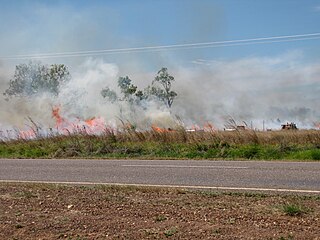 W
WClimate change opinion is the aggregate of public opinion held by the adult population. Cost constraints often restrict surveys to sample only one or two countries from each continent or focus on only one region. Because of differences among questions, wording, and methods—it is difficult to reliably compare results or to generalize them to opinions held worldwide.
 W
WRegional effects of climate change or global warming are long-term significant changes in the expected patterns of average weather of a specific region due to global warming. The world average temperature is rising due to the greenhouse effect caused by increasing levels of greenhouse gases, especially carbon dioxide. When the global temperature changes, the changes in climate are not expected to be uniform across the Earth. In particular, land areas change more quickly than oceans, and northern high latitudes change more quickly than the tropics, and the margins of biome regions change faster than do their cores.
 W
WClimate change in Australia has been a critical issue since the beginning of the 21st century. Australia is becoming hotter, and more prone to extreme heat, bushfires, droughts, floods and longer fire seasons because of climate change. Since the beginning of the 20th century Australia has experienced an increase of nearly 1 °C in average annual temperatures, with warming occurring at twice the rate over the past 50 years than in the previous 50 years. Recent climate events such as extremely high temperatures and widespread drought have focused government and public attention on the impacts of climate change in Australia.
 W
WStrategies for climate change adaptation in Bangladesh are being developed and implemented as climate change is a pressing issue in Bangladesh. The country is one of the most impacted by climate change. Factors such as frequent natural disasters, lack of infrastructure, high population density, an extractivist economy and social disparities are increasing the vulnerability of the country in facing the current changing conditions. Iin almost every year, large regions of Bangladesh suffer from more intense events like cyclones, floods and erosion. The mentioned adverse events are slowing the development of the country by bringing almost to collapse socio-economical and environmental systems.
 W
WClimate change in Ghana will have wide-reaching impacts on the country. Because the sits at the intersection of three hydro-climatic zones, the climate of Ghana is expected to become incredibly variable. Based on a 20-year baseline climate observation, it is forecasted that maize and other cereal crop yields will reduce by 7% by 2050. Available data also shows a sea level rise of 2.1 mm per year over the last 30 years, indicating a rise of 5.8 cm, 16.5 cm and 34.5 cm by 2020, 2050 and 2080.
 W
WClimate change adaptation is a pressing issue in Greenland. The term climate change describes long-term changes to the climate system. Since the 1950s a stark rise in global temperatures has been observed. As climate change, whether natural or anthropogenic, impacts the livelihoods of people across the globe, responses i.e. ways to prepare and adjust under changing vulnerabilities become important. Such responses are commonly discussed under the term adaptation, "the process of adjustment to actual or expected climate and its effects", as defined by the IPCC.
 W
WClimate change in Indonesia is of particular significance, because its enormous coastal population is particularly at risk to sea level rise and because the livelihoods of so many of its people depend on agriculture, mariculture and fishing, all of which could be severely impacted by temperature, rainfall and other climatic changes. Some environmental issues in Indonesia such as the cutting of mangrove forests to make room for fish farms further worsen the effects of climate change.
 W
WClimate change in Kenya is increasingly affecting Kenya's citizens. This is having effects on the people living in Kenya, creating water security challenges and putting pressure on major parts of the economy. At the beginning of 2020, some part of the country was affected by massive locust infestation. Climatic change impacts such as the increase in temperature and rainfall variability in desert areas, and the strong winds associated with tropical cyclones, offer a conducive environment for pest breeding, development and migration. Attribution of infestation to climate change is however quite difficult. Climate projections suggest an increase in temperature of up to 2.5°C between 2000 and 2050, and an increasing frequency of extreme events, such as floods and droughts.
 W
WClimate change in Mexico is expected to have widespread impacts on Mexico: with significant decreases in precipitation and increases in temperatures. This will put pressure on the economy, people and the biodiversity of many parts of the country, which have large arid or hot climates. Already climate change has impacted agriculture, biodiversity, farmer livelihoods, and migration, as well as "water, health, air pollution, traffic disruption from floods, [and] housing vulnerability to landslides." Altered precipitation patterns and warming temperatures has led to economic insecurity in Mexico, particularly for smallholder farmers, and have laced significant burdens on Mexico’s economically and culturally important crops: maize and coffee. Climate change impacts are especially severe in Mexico City due to increases in air pollution. Ecological impacts of climate change within Mexico include reductions in landscape connectivity and shifting migratory patterns of animals. Furthermore, climate change in Mexico is tied to worldwide trade and economic processes which relates directly to global food security.
 W
WClimate change in North Korea is an especially pressing issue. North Korea is highly vulnerable to the effects of global warming due to its weak food security, which in the past has led to widespread famine. The North Korean Ministry of Land and Environmental Protection estimates that North Korea's average temperature rose by 1.9°C between 1918 and 2000.
 W
WClimate change in Pakistan is expected to cause wide-ranging effects on the environment and people in Pakistan. As a result of ongoing climate change, the climate of Pakistan has become increasingly volatile over the past several decades; this trend is expected to continue into the future. In addition to increased heat, drought and extreme weather conditions in some parts of the country, the melting of glaciers in the Himalayas threatens many of the most important rivers of Pakistan. Between 1999 and 2018, Pakistan was ranked the 5th worst affected country in terms of extreme climate caused by climate change.
 W
WClimate change in Senegal will have wide reaching impacts on many aspects of life in Senegal. Climate change will cause an increase in average temperatures over west Africa by between 1.5°C and 4°C by mid-century, relative to 1986–2005. Projections of rainfall indicate an overall decrease in rainfall and an increase in intense mega-storm events over the Sahel. The sea level is expected to rise faster in West Africa than the global average. Although Senegal is currently not a major contributor to global greenhouse gas emissions it is one of the most vulnerable countries to climate change.
 W
WClimate change has highly impacted South Africa, primarily due to increased temperatures and rainfall variability. Evidence shows that extreme weather events are becoming more prominent due to climate change. This is a critical concern for South Africans as climate change will affect the overall status and wellbeing of the country, for example with regards to water resources. Just like many other parts of the world, climate research showed that the real challenge in South Africa was more related to environmental issues more than developmental ones. The most severe effect will be targeting the water supply, which has huge effects on the agriculture sector. Speedy environmental changes are resulting clear effects on the community and environmental level in different ways and aspects, starting with air quality, to temperature and weather patterns, reaching out to food security and disease burden.
 W
WGlobal warming is particularly threatening in Tuvalu. This is because the average height of the islands is less than 2 metres (6.6 ft) above sea level, with the highest point of Niulakita being about 4.6 metres (15 ft) above sea level. Between 1971 and 2014, during a period of global warming, Tuvalu islands have increased in size, according to aerial photography and satellite imagery. Over four decades, there was a net increase in land area in Tuvalu of 73.5 ha (2.9%), although the changes were not uniform, with 74% of land increasing in size and 27% of land decreasing in size. The sea level at the Funafuti tide gauge has risen at 3.9 mm per year, which is approximately twice the global average.
 W
WClimate change in the United Kingdom has been a subject of protest and controversies and various policies have been developed to mitigate its effects. The government has a commitment to reduce greenhouse gas emissions by the United Kingdom by 50% on 1990 levels by 2025 and by 100% on 1990 levels by 2050. In May 2019, Parliament declared a 'climate change emergency', however this does not legally compel the government to act.
 W
WVietnam is considered, in coming decades, to be among the most affected countries by global climate change. A large number of studies show that Vietnam is experiencing climate change and will be severely negatively affected in coming decades. These negative effects include sea level rise, salinity intrusion and other hydrological problems like flood, river mouth evolution, sedimentation as well as the increasing frequency of natural hazards such as cold waves, storm surges will all exert negative effects on the country's development and economy including agriculture, aquaculture, road infrastructure, etc.